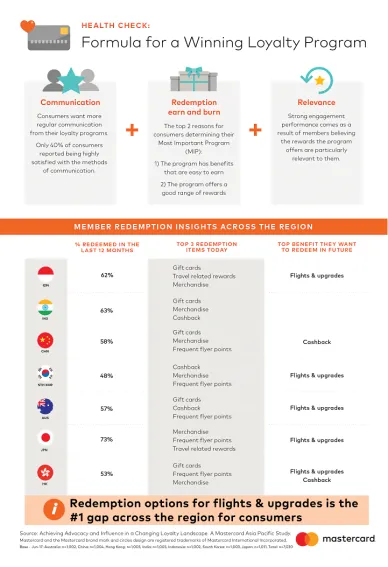
Study reveals significant growth opportunities in Asia-Pacific's loyalty landscape
CONSUMERS in emerging Asia-Pacific markets are embracing loyalty programmes with gusto, while their peers in developed markets express a more reserved sentiment, Mastercard’s inaugural multi-market study on Asia-Pacific’s loyalty landscape revealed. Despite the variances in perception, the research signals room for growth across the region to enhance the appeal of loyalty cards.
The Mastercard loyalty insights study titled Achieving Advocacy and Influence in a Changing Loyalty Landscape, conducted across seven markets — Australia, China, Hong Kong, India, Indonesia, Japan and South Korea — found that the loyalty market is at different levels of maturity across the region in view of shifting consumer expectations and needs in each market.
Felix Marx, executive vice-president of services, Asia-Pacific, Mastercard, said: “The loyalty landscape in Asia-Pacific is a competitive space with many players battling to stay top of a consumer’s loyalty wallet. Loyalty programme providers now need to move away from traditional earn-and-burn levers and invest in smarter initiatives that will influence consumer behaviour and ensure loyalty for the longer term.”
Using the Net Promoter Score (NPS) — a management tool used to gauge the loyalty of a firm’s customer relationships — the study found that the regional average score was -5, signifying the potential for greater advocacy and influence on consumers’ spending habits. This indicates today’s consumers demand immediate rewards, greater personalisation and a more secure and convenient experience as they look for gratifying experiences.
The NPS results reflected a significant contrast between the markets as well. Emerging markets China (+14), Indonesia (+19) and India (+37) have a healthy appetite for such programmes. Conversely, the NPS for Australia (-6), Hong Kong (-26), South Korea (-38) and Japan (-39) displayed a more jaded outlook, where the loyalty landscape is well-enrenched and highly competitive.
The study identified three key pillars to ensure a successful loyalty An infographic on Mastercard's loyalty insights for the year 2018, featuring formulas for a winning loyalty programme, redemption options and benefits. programme: Enhanced digitisation; greater levels of personalisation; and improved modes of communication.
1. Go digital
Asia-Pacific is undergoing digitisation at a rapid rate, with 96% having access to a mobile phone — higher than any other region. Despitethis, Mastercard’s research found that only 40% of the consumers polled can interact with their loyalty programmes via a mobile app. Digitising is crucial to engaging with consumers and adding value to their loyalty experience by displaying offers and points balance more conveniently.
2. Get personal
The study revealed that much more can be done in terms of curating experiences for each individual customer and maintaining regular two-way communication. Across the region, only 36% were highly satisfied with the level of personalisation. The majority (71%) of consumers were willing to disclose details about themselves in order to receive a more relevant experience.
3. Communicate better
Loyalty programme providers should cater to the consumers’ preferences when it comes to the frequency and modes of communication. Regular communication alone is not enough as consumers prefer to be communicated with in their preferred channel about personally relevant subjects.
Those who delivered on these programmes will be able to reap the benefits of greater spending. An overwhelming 70% of consumers said their most valued loyalty programme which had more effective digital interoperability, personalised privileges and improved on relevant communication modes would be very influential on their shopping, payment or travel behaviour.



















 Advertise
Advertise






